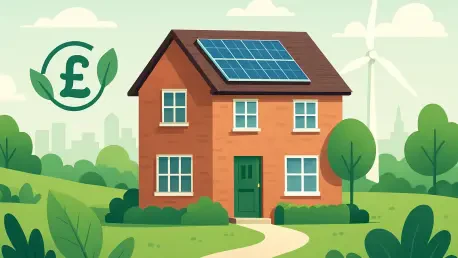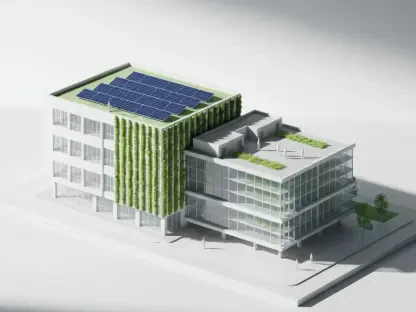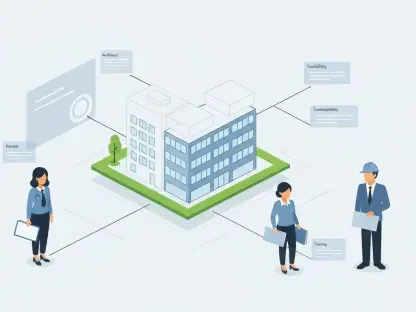In a world increasingly grappling with the urgent need to combat climate change, the UK stands at a critical juncture where the housing sector could play a transformative role in achieving environmental goals. Imagine a future where every new home or renovation not only meets modern living standards but also significantly reduces carbon footprints through innovative financing. The mortgage industry, handling billions in annual transactions, is now being positioned as a key driver in this sustainability revolution. A strategic initiative has emerged to channel these vast financial resources toward making residential properties more energy-efficient and resilient to climate risks. This effort, supported by a coalition of industry leaders, aims to align the housing market with national targets like net zero emissions by 2050, offering a glimpse into how financial tools can reshape the environmental impact of homes across the nation.
Pioneering a Sustainable Mortgage Market
The Strategic Framework for Green Financing
The Green Home Finance Roadmap (GHFR), developed through a collaboration between prominent industry bodies, marks a significant step toward integrating sustainability into the UK mortgage sector. This comprehensive plan, backed by 34 organizations spanning finance, energy, and construction, serves as a blueprint for leveraging the £242 billion annual mortgage market to enhance home energy efficiency. Crafted through extensive consultations with lenders, brokers, and retrofit experts, the roadmap outlines five actionable focus areas in a streamlined, one-page guide. This practical tool is designed to foster industry-wide alignment, ensuring that stakeholders can work cohesively to address both decarbonization and climate resilience. Beyond its strategic design, the roadmap also amplifies the impact of industry events and discussions, creating platforms for collaboration and accelerating progress toward sustainable housing solutions that benefit homeowners and the environment alike.
Industry Collaboration as a Driving Force
Beyond the structural framework, the GHFR emphasizes the power of collective action within the mortgage industry to drive meaningful environmental change. Industry leaders have highlighted the importance of moving away from fragmented efforts and redundant conversations, instead using the roadmap to monitor advancements, recognize milestones, and pinpoint emerging challenges. This unified approach, often described as a “country not club” mindset, reflects a shared commitment to tackling the climate crisis through innovative financing. Voices from key associations underscore the roadmap’s role in embedding green principles into routine mortgage advice, while others praise its clarity in navigating the complexities of sustainable finance. Such collaboration ensures that the industry can mobilize resources effectively, creating a ripple effect that encourages homeowners to adopt energy-efficient upgrades while aligning with broader national climate objectives.
Addressing Demand and Overcoming Barriers
Public Interest in Green Mortgage Products
A striking insight from recent research reveals a strong public appetite for green mortgages, particularly among specific demographics in the UK. Surveys indicate that half of all homeowners express a keen interest in financial products that support the purchase or upgrade of energy-efficient properties, with an even higher 80% of first-time buyers in Scotland showing enthusiasm for such options. This demand signals a readiness among the population to embrace sustainable living, provided the right tools and opportunities are accessible. However, translating this interest into action requires more than just enthusiasm; it necessitates targeted efforts to raise awareness and ensure that prospective buyers understand the long-term benefits of energy-efficient homes. The GHFR aims to bridge this gap by prioritizing public engagement, positioning green mortgages as not just an environmental choice but also a financially savvy one for future generations of homeowners.
Tackling Obstacles to Adoption
Despite the evident demand, significant hurdles remain in making green mortgages a mainstream option for UK homeowners. One of the primary barriers is the limited availability of suitable financial products tailored to support sustainable home improvements. Additionally, there is a clear need for enhanced public education to demystify these offerings and highlight their practical advantages, such as reduced energy costs and increased property resilience against climate risks. The GHFR identifies these challenges and advocates for solutions like improved access to financing and better integration of green advice into the mortgage process. At the same time, the industry recognizes that decarbonization must go hand in hand with building homes that can withstand environmental challenges, ensuring a dual focus on reducing emissions and enhancing durability. Addressing these obstacles is crucial to unlocking the full potential of green mortgages as a catalyst for sustainable living across the nation.
Mobilizing Financial Power for Climate Goals
The Scale of Investment Needed
The financial implications of achieving net zero in UK residential properties are staggering, with estimates from the Climate Change Committee suggesting a need for £311.5 billion in capital investment by 2050, largely from private sources. The mortgage industry, with its substantial market influence, is uniquely positioned to play a pivotal role in mobilizing these funds. Through the GHFR, the sector is encouraged to direct its resources toward sustainable home improvements, effectively turning mortgages into tools for environmental progress. This redirection of capital not only addresses the urgent need to reduce carbon emissions but also supports the creation of homes that are future-proofed against climate challenges. By harnessing the financial power of the mortgage market, the initiative seeks to ensure that the necessary investments are made to transform the housing landscape, aligning it with national sustainability targets.
Building Capacity Through Education
Alongside financial mobilization, capacity-building within the industry remains a cornerstone of the GHFR’s approach to sustainable housing. Efforts to expand green mortgage training programs, particularly in regions like Scotland, demonstrate a commitment to equipping professionals with the knowledge and skills needed to advocate for energy-efficient solutions. These educational initiatives aim to create a workforce capable of guiding homeowners through the complexities of green financing, ensuring that advice is both informed and actionable. By fostering a deeper understanding of sustainable practices among lenders and brokers, the roadmap seeks to embed environmental considerations into every stage of the mortgage process. This focus on education complements the broader financial strategy, creating a robust foundation for long-term change in how homes are financed and built to meet the demands of a changing climate.
Reflecting on a Unified Path Forward
Looking back, the journey of integrating sustainability into the UK mortgage industry through the Green Home Finance Roadmap proved to be a landmark effort that united diverse stakeholders around a common vision. The collaborative spirit that defined this initiative set a precedent for how industries could tackle complex challenges like climate change with shared purpose. Moving forward, the focus shifted to actionable steps, such as expanding access to green mortgage products and enhancing public awareness through targeted campaigns. Industry leaders also prioritized continuous updates to the roadmap, ensuring it remained responsive to evolving needs and technological advancements. This adaptability, coupled with ongoing investment in professional training, laid the groundwork for a mortgage market that not only supported sustainable homes but also inspired other sectors to adopt similar collective strategies in addressing global environmental goals.









